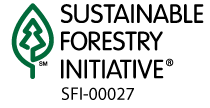xxx,xxx,xxx,xxx
METRIC TONS OF CO2
EQUIVALENT TO
SCRUBBING FROM THE AIR THE ANNUAL
CO2 EMISSIONS FROM xxx.xxx,xxx,xxx VEHICLES

The forests of tomorrow are growing today: Many people do not realize that companies such as Sierra Pacific Industries are growing more trees than they are harvesting. Today, the average size tree at harvest on Sierra Pacific lands is approximately 18 inches in diameter. In less than one hundred years the average size tree at harvest will be in excess of 30 inches in diameter, and we will nearly triple our current forest volume. Put succinctly, we will have more large trees on our timberlands 100 years from now than we do today and almost three times the wood volume. That’s progress.
Trees produce clean oxygen: Carbon dioxide, produced by burning fossil fuels like gasoline, contributes to an atmospheric warming phenomenon that scientists call the greenhouse effect. The good news is that through natural processes, growing trees convert carbon dioxide into oxygen for us to breathe.
The way we manage our forests: When trees mature we harvest them to make wood products for consumers. In their place Sierra Pacific plants new trees creating the next generation of forests. Harvest cycles are separated by long periods of time and involve cutting only a tiny percentage of the existing trees on Sierra Pacific lands. In California and Washington, timber harvests are conducted only after a review and approval by state regulatory agencies.
SUSTAINABILITY
Many species of trees require open sunlight to thrive: Often, people become concerned when they see openings in the forest created through timber harvesting. However, appearances can be deceiving. By opening up the forest and allowing the sunlight to hit the ground, new seedlings are allowed to grow to their maximum potential. To create this environment we use “even-aged” management. This is carried out under very strict rules that guarantee reforestation and protection of water quality, wildlife habitat, and other resources.
Our forests maintain biodiversity: Maintaining biodiversity is one of the goals of Sierra Pacific’s land management. Promoting a natural mix of flora and fauna is important to our timberland managers. That’s why Sierra Pacific grows a wide array of native tree and shrub types vital to the survival of the many wildlife species that inhabit our forestlands. Sierra Pacific has special landscape plans designed to ensure the survival of sensitive species, such as the Northern Spotted Owl and the Pacific Fisher.
Fast growing, healthy trees store more carbon: Fast growing, healthy trees store more carbon than an over-mature forest. As a tree grows, it stores carbon in its trunk, branches and roots and produces the oxygen that we need. This Carbon Cycle is important to the environment. As a result of investments made today, Sierra Pacific will be producing wood products that will store carbon for centuries.

